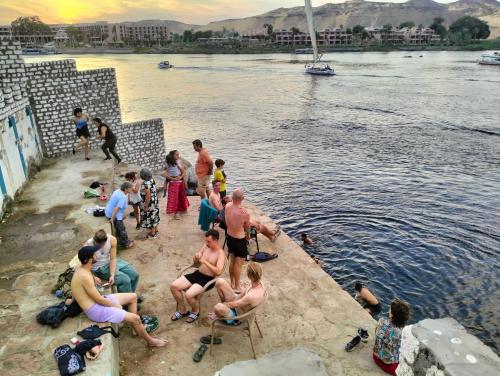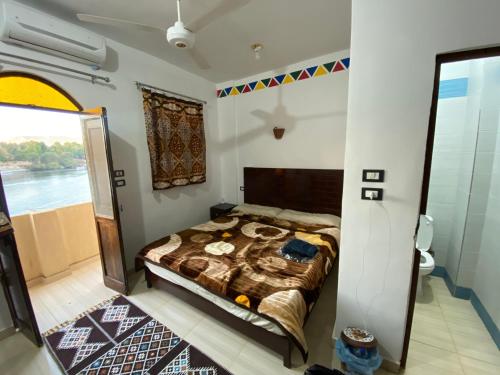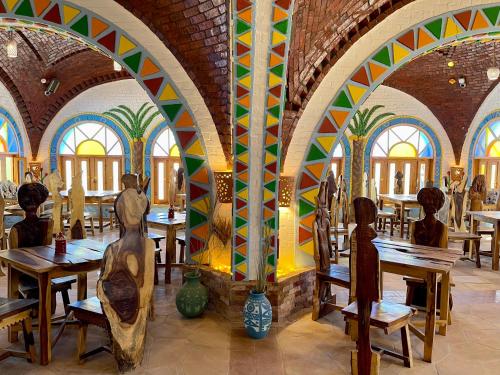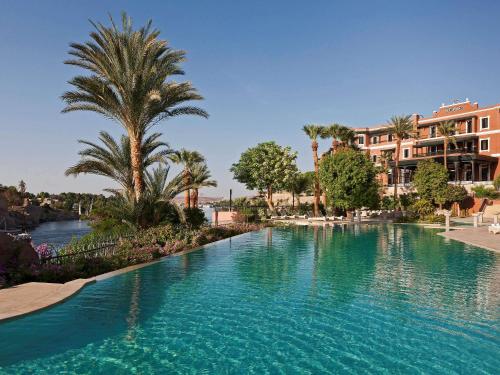The walls of the temples at Philae are covered in ancient hieroglyphs. Amongst the large carvings of the gods of Ancient Egypt are the inscriptions in the ornate pictorial alphabet, telling the stories of this civilisation.
Travelling around Egypt, you see a lot of hieroglyphs – but there is something special about the ones at Philae. They were the last to be written by the Ancient Egyptians.
There’s one inscription in particular that mentions a date and so it has been officially declared as the last written Egyptian hieroglyphs. It even has an official name – the Graffito of Esmet-Akhom – and is dated August 24, 394 AD (although, of course, the date is in the Ancient Egyptian calendar and actually refers to the day of the birth of the god Osiris).
It’s one of the highlights of Philae Temple, but it’s just one of the many fascinating things you’ll discover if you make the trip out here from Aswan.
The easiest way to see Philae Temple is with a guided tour, and I would recommend this excellent one from Aswan.
The temple complex of Philae is built on an island in the Nile River near Aswan (and I’ll tell you shortly why that is significant).
When you visit Philae today and hear about its history, it’s clear that the writing was on the wall for the Ancient Egyptians.
The oldest of the temples on the island was built by the last of the pharaohs who was actually Egyptian (Nectanebo II, who died in 343 BC). His successor was Macedonian, part of the Ptolemaic dynasty that began with the death of Alexander the Great and ended with the death of Cleopatra.
Although they were Macedonian (or Greek, depending on how you look at it), this new dynasty was clever enough to realise that it would only be able to rule Egypt if the leaders seemed to be Egyptian. And so they dressed like Egyptians, worshipped the Egyptian gods, and built their monuments in the Egyptian style.
Which brings us to Philae Temple.
As I start to walk through the complex, looking at the architecture and the artwork on the walls, it looks Egyptian enough to me. But for experts, there are clear signs that much of it was built by the Greeks, trying to impersonate the Egyptians.
In the broader region here, in the last few centuries BC and first few centuries AD, the world was changing. Political upheaval was on the horizon and the sun setting on the Ancient Egyptian civilisation was only part of it. Soon, Rome would rule this land, along with much of the world.
It was during Roman rule that the last hieroglyphic inscriptions were done here at Philae – but the Roman Emperors had shown respect previously. Augustus and Tiberius both added decorations and the famous emperor Hadrian added a gate to the complex.
But, ultimately, what you find at the Philae temples is the last refuge of a culture that was disappearing around it, kept alive because of benefactors who saw a political benefit in its association.
With this in mind, perhaps it’s fitting that Philae is on an island.
From a visitor’s perspective, it means arriving at Philae is part of the experience. You need to catch a boat from a small dock on the mainstream that takes about 15 minutes to putter over to the island.
I love the view as you approach, the columns and intact walls rising up from this large rock in the middle of the water.
Philae has always been in the middle of the Nile, even from when it was first built more than 2000 years ago. But after the Aswan Low Dam was finished in 1902, it was quite often literally in the Nile, with constant flooding.
So, when the larger project began in the 1960s to move historical sites like Abu Simbel to protect them from the waters of the newer (and much larger) Aswan Dam, Philae Temple was also included.
A nearby island was modified to be approximately the same shape as the original and the temples were moved and restored, now in a better than they had been in centuries.
You see it as you walk across the island of Philae, starting with the enormous facade with the carved images of the god Horus, through courtyards lined with collonades, and into the darkened core of the temple complex.
Throughout it all, every inch seems to be covered with hieroglyphs. It’s almost as if they knew it would be the last time they would be used and they wanted to make the most of it.
I find the design of Philae really beautiful. Even though it was built in stages, everything fits together harmoniously with the other parts of the temple complex. Even more importantly, it also fits with its surroundings – the water, the other small islands, and the shorelines.
I think it’s also quite meaningful to see both Philae and Abu Simbel when you come to Aswan. Don’t dismiss them just as “two Egyptian temples”. they are both magnificent in their own ways and they represent such different eras of history and different designs.
In fact, you could argue that Philae Temple represents a few eras. Not just Ancient Egypt, on which the design is based, or the Ptolemaic Kingdom, during which much of it was built.
It also clearly represents the later Roman Empire and beyond, as Christianity spread across these lands. You can see this in the way that so many of the bas-reliefs on the walls have had the faces and bodies of the gods chiselled away by Christians.
If you look closely, you can also find some places around Philae where crosses have been carved into the stone, marking a spot where Christians worshipped (possibly while they took refuge).
When I first saw the way the images of the gods had been defaced, I felt angry that people would do this. But, of course, it’s more complicated than simple vandalism, it’s twisted up with religious faith.
But there’s also another way to look at it, the way I decided to view these faceless Egyptian gods. They represent a shift in the civilisations of this land. They show that empires rise and fall and nothing that is great stays that way forever.
It is just like the last hieroglyphs. I can’t be angry that there were no more of them, just like I can’t be angry that people took chisels to the images around them. They both say the same thing.
Visiting Philae Temple
The two main reasons that people pass through Aswan are to visit Abu Simbel or to start a river cruise along the Nile. But there are actually quite a few things to do in Aswan itself, so it’s worth a day or two.
One of the highlights is Philae Temple, so I really do recommend making the time to see it, if you can.
It is possible to get from Aswan to Philae Temple independently, but it can be a little bit of a hassle because the temple is on an island in the reservoir.
First you’ll have to get to where the boats leave, which is called Marina Philae Temple. It’s on the eastern side of the reservoir and is about eight kilometres south of Aswan. The easiest option is to get a taxi there, which will take about 15 minutes.
When you’re there, you’ll buy your ticket to the temple on shore, but then have to negotiate with the crowd of boat drivers, because there is no set fee. Because you’re basically a captive audience, you’re not going to get a good deal, but hopefully you can act savvy enough to not get ripped off.
Because of the two steps and the need to haggle for both, I would recommend taking a tour instead. Both group tours and private tours are really affordable from Aswan and may not cost you much more than doing it independently. (It may even be cheaper if you’re a bad negotiator.
I think the best tour option is this private tour from Aswan which is great value and can be done in several different languages.
Some other good tours I would recommend – some with extra sights – are here:
Whether you’re with a guide or you’re seeing it independently, I would recommend at least an hour on the island. It’s not a huge area but there is quite a lot of detail, so an hour gives you time to look at everything without rushing.
A few other useful bits of visitor information:
- Most of the island isn’t shaded, so make sure to bring sun protection with you.
- There is a little cafe on the island, but I would still recommend bringing some water (and maybe snacks) with you.
- Photography with a mobile phone is free, but you’ll probably be charged for a large camera or a tripod.
- Although there is no official dress code, I would recommend dressing modestly – so no singlets, short shorts, or short skirts.
If you’re travelling independently and are trying to plan your day, it’s worth noting that there are quite a lot of small shops at Marina Philae Temple. You’ll be able to buy drinks and snacks, but probably not a decent meal for lunch.
Where is Philae Temple?
Philae Temple is located about eight kilometres south of Aswan, in southern Egypt. The temple is on an island in the reservoir of the Aswan Low Dam, downstream of the main Aswan Dam and Lake Nasser.
You can see it on a map here.
How do you get to Philae Temple?
Because Philae Temple is located on an island in the reservoir of the Aswan Low Dam, you’ll need to get a boat there from shore. The boats leave from Marina Philae Temple, on the eastern side of the reservoir, about eight kilometres south of Aswan.
The easiest way to get to Marina Philae Temple is by taxi. Once there, you’ll need to negotiate with the boat operators for a price to get to the island – unfortunately there isn’t a set fee.
Because of these logistics, I would recommend taking a tour from Aswan, because they are quite affordable so may not cost you more than if you arrange the taxi and boat yourself.
When is Philae Temple open?
Philae Temple is open daily from 7:00 – 16:00.
What is the Philae Temple entrance fee?
Philae Temple entrance fee is EGP 550 (US$8.90) for a standard ticket and EGP 275 (US$7.50) for a student.
Are there tours to Philae Temple?
Yes, there are tours to Philae Temple from Aswan and I actually think they’re the best way to visit the site.
There is this private tour that is great value and probably the best option.
Another great choice is this private tour from Aswan that also includes the High Dam and the Unfinished Obelisk.
Or there’s this fun tour that adds on a visit to a Nubian village.
You can see more information at the official website of Philae Temple.
To visit Philae Temple properly, I think you need to come during the day, when the walls covered in carvings are bathed in sunlight. But there is an interesting night activity I want to mention – a sound and light show!
The show takes place in different parts of the temple, with a narration over the speakers telling the story of the site, as the lights change colour. You’ll get to see some of the temple’s highlights, but you don’t get the opportunity to wander around anywhere else.
You can book the show and transfers here, if you’re interested. I definitely think it’s a cool experience and, if you’re only in Aswan for an evening, is much better than not seeing Philae Temple at all!
THE BEST ACCOMMODATION IN ASWAN
Most of the good accommodation in Aswan is quite close to the Nile, although you’ll often get better value further back into the city.
BACKPACKER

Right on the Aswan waterfront, the Go Inn Backpackers Hostel even offers direct swimming access to the Nile!
BUDGET

You’ll find a warm welcome at Abazido Nubian Guest House, plus there’s a rooftop terrace and breakfast is included.
BOUTIQUE

Set in a colourful handmade Nubian building, Kato Dool Wellness Resort has terraces for every room.
LUXURY

With views over the Elephantine Islands, Sofitel Legend Old Cataract also has an amazing indoor and outdoor pool.
I travelled to Egypt with the support of G Adventures in my position as a G Wanderer. All the opinions expressed are my own – I truly believe G Adventures is one of the best tour companies that you can use for a trip to Egypt.